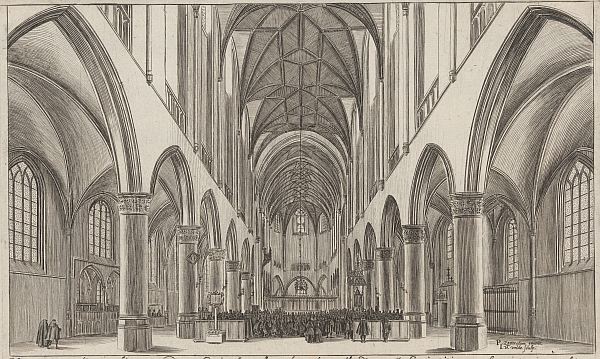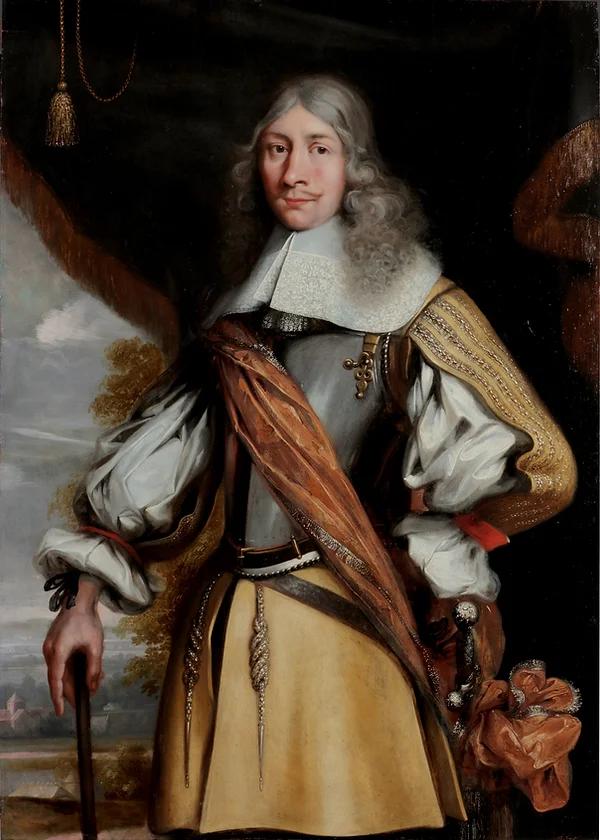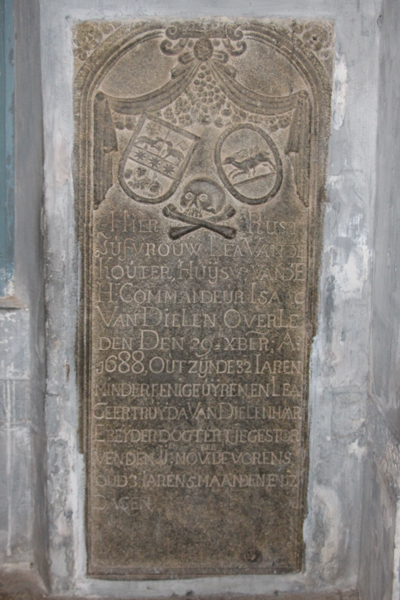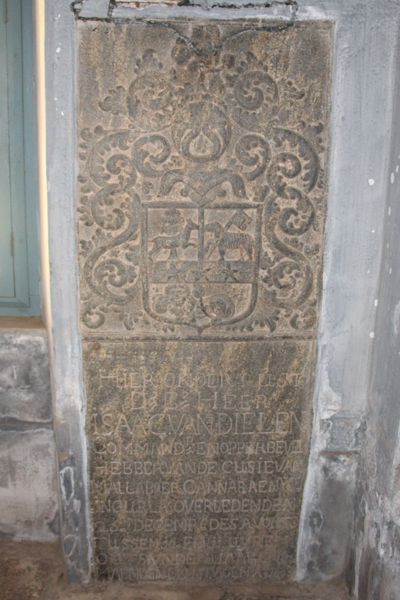Fort Kochi - Isaac Pieterszn van Dielen and Lea de Kouter
On 6 April, 1663, little Lea de Kouter walked with her mother to the cabin of a ship on the roadstead of the Cape of Good Hope. A girl with the beautiful name Virena would be baptized that morning. [i] The vicar who was to baptize the child, Balthasar de Meter, had just arrived from Holland and was due to sail on to the Indies. She had just arrived from the Indies and was going to travel through to Holland, a unknown country to her. Would they have consciously seen each other? Would Lea remember him when, years later, she arrived at Cochin and found his tombstone in the church, not aware that they would soon be buried together in the same church forever?
On 5 May 1652, Isaac, son of Pieter van Dielen and Geertrui Nicasius, was baptized in the St.-Bavo church in Haarlem. He was the second son of the couple who had a son Willem baptized in 1650 and Janneke in 1654.[ii] Nothing is known about the background of his father Pieter, but he must have been well-to-do since shortly after the death of his wife[iii] he remarried in Haarlem to Susanna Huijsman, daughter of Anthony Huijsman, notary in Rotterdam and since 1646 in Batavia, and Lea van Waesberghe. For Susanna, it was her third marriage after having previously been widowed by the VOC merchant Philips van Arts and by sub-merchant Jacob de Kouter.[iv]
 Interior of the St Bavo Church in Haarlem in 1628 (Rijksmuseum RP-P-1930-136)
Interior of the St Bavo Church in Haarlem in 1628 (Rijksmuseum RP-P-1930-136)
A new family on their way to the Indies
It became an extended family. In addition to Pieter's three children, Susanna had children of her second husband: Geertruijda (Tayoean 1653), Pieter (Tayoean 1655), Lea (Tayoean 1656), Susanna (Batavia 1659). Together they also had at least three children: Anthoni, baptized in Haarlem 8 November 1665, Johannes, baptized in Haarlem 25 September 1667 and Catharina Africana, born 7 June 1670. [v] It is inevitable that in the busy household the conversations were often about the East Indies and the VOC. In addition to the fact that Susanna's children from her second marriage were all born there, Susanna's father, brothers and sister also lived there. A crossing to the Indies could be arranged in two ways: register with the VOC and go as a staff member or sail along as a paying passenger. Around 1670, a crossing for a male passenger was costing 190 rijksdaalders, for a woman 160 rijksdaalders and for a child under the age of twelve 77 rijksdaalders. Then there was housing and food for a man and woman in the cabin 30 and 18 pennies respectively, in the cabin 18 and 12 pennies or with the common people and then you lost 9 pennies per meal. The bill for Pieter van Dielen would then be very high, assuming that he wanted to leave in 1668. For Pieter and Susanna and 7 children (4 men, 5 women) the full price was counted and for the 3 children under twelve there was some discount. Assuming that all the children went along, the crossing alone would cost a good four and a half thousand guilders, without food and drink. Yet the family made the crossing one way or another. Research showed that no traces of little Johannes van Dielen can be found in the Indies, so he probably died young. From the presence of Anthoni van Dielen and Catharina Africana van Dielen it can be deduced that Pieter and Susanna also arrived in the Indies and this is also evident from the registration of Dutch children in Jaffanapatnam in 1678. Pieter van Dielen's widow lives there with a son and a daughter aged 8 and 12.[vi] [vii]
The Dielen brothers
Willem and Isaac van Dielen were 18 and 16 years old respectively in 1668. Old enough to join the VOC and they did. Isaac came to Batavia as a midshipman with the Gekroonde Vrede of the Chamber Enkhuizen, Willem had sailed on the same ship as a soldier. [viii] The marriage between father Pieter and stepmother Susanna was favorable in the sense that Susanna's brothers, namely Marten and Johannes, both already had a good function in Ceylon and could perhaps help them. After arriving in Batavia in January 1669, William and Isaac soon moved on to Ceylon. There, Isaac was appointed as an assistant. On which ship and in what capacity the other family members made the crossing to the Indies, cannot be found with certainty. [ix] But that the family was strongly connected to Ceylon is evident from everything.
Soon after the arrival of the family, a good match was found for Susanna's eldest daughter, Geertruida de Kouter. Around 1670 (about 17 years old) she married the minister of Colombo, Simon de Kadt. Girls in the Indies usually married much younger than was customary in the Netherlands. The third daughter and namesake of Susanna married the other pastor of Colombo, Hermannus Specht, around the age of seventeen. Pieter's daughter, Janneke, became the bride of Colombo's commander, Laurens Corneliszn Pijl. Lea, who turned 17 in December 1673, sought it much closer. She married her stepbrother Isaac van Dielen. Stepparents became in-laws [x] , step-siblings became in-laws. The ties became closer.
Isaac's successful career
Isaac was appointed provisional assistant at Ceylon by Rijkloff van Goens, who had a loyal follower in Lea's uncle Marten Huijsman, with an income of 16.00 guilders per month. In 1673, probably in connection with his marriage to Lea de Kouter, he was promoted to accountant with a salary of 32.00 guilders per month. Goens the young promoted him in 1676 to sub-merchant in Jaffanapatnam with 36.00 guilders per month and in 1679 to provisional merchant. In 1681, the General and Councils of India promoted him to merchant with a salary of 60.00 guilders per month. In 1685 Hendrick Adriaan van Rheede promoted him to chief merchant with a salary increase to 80.00 guilders per month and in 1687 he was appointed commander of the Malabar by the Governor-General himself. [xi] No doubt he had been helped in the saddle at the beginning of his career, but the fact that his appointments from 1681 onwards could no longer be linked to family relationships served him well later.
 Portrait Rijkloff van Goens in 1653. Isaac van Dielen was his assistant on Ceylon and later on promoted him.
Portrait Rijkloff van Goens in 1653. Isaac van Dielen was his assistant on Ceylon and later on promoted him.
On 29 July, 1687, Isaac arrived in Cochin with the Drakesteijn and on 14 September he was introduced to "the people". His family had stayed behind in Ceylon, but also came to Cochin in the course of 1688. He found a post that had known many other heads in recent years and in which most of the commanders were in favor of a hard line, including his uncle Marten Huijsman. [xii] Van Dielen was tasked with restoring trust between the VOC and the kingdom of Cochin and its monarchs and re-establishing a form of respect for each other. The fact that he got along well with the royal family must have contributed to that. That it was not always peace and quiet was evident when he had to go to war against both the surrounding kingdoms and his European enemies the Portuguese.
Isaac's health was a problem. He was severely ill several times. This was also the case in the second half of 1688. He could barely be saved by Dr. Engelbert Kaempfer. The help came too late for his daughter Lea Geertruyda who died on 11 November, less than three and a half years old, and his wife Lea who passed away on 29 December 1688, nearly 32 years old. They were buried in the same grave in St. Francis church, the church in which Balthasar de Meeter also was buried. The news that his brother William with his children Catherine and a newborn son had also died of the plague on 13 December of the same year on the coast of Coromandel in Pulicat must have hit Isaac hard.
 Slab of Lea de Kouter (photo René ten Dam, 2020)
Slab of Lea de Kouter (photo René ten Dam, 2020)
As early as 1689, Isaac asked to be allowed to leave for a - for him - healthier place, but this was refused again and again. In the summer of 1690 he became so seriously ill that he could not work and would only partially recover. Probably in 1693 he married again, this time to Maria Scholten. Maria was the sister of Johannes Scholten, who worked in Cochin as secretary of police. Just as Laurens Pijl had already had to defend himself in 1684 because of the too close connection with the Huijsman and Dielen families, and just as Willem van Dielen was therefore put back in position, it was now Johannes Scholten's turn to avoid the appearance of a conflict of interest because of his brother in law. He was removed from office, but appointed receiver of the tolls and rights.
However, the marriage of Isaac and Mary did not last long. After he had asked for another transfer in 1693 and the Hoge Regering again could not make a decision, he died after a "long-term, very horrible disease" on 5 December 1693 and was buried in Cochin where his stone is now bricked into the wall of St. Francis Church.
 Slab of Isaac van Dielen (photo René ten Dam, 2020)
Slab of Isaac van Dielen (photo René ten Dam, 2020)
The tombstones for Lea de Kouter and Isaac van Dielen are richly decorated, with the slab for Lea being slightly simpler in execution, while the slab for Isaac looks very European. Isaac may have had the slab made in the Netherlands or in Batavia. The text plane most likely was carved in Cochin after his death. What is striking is that most Dutch slabs in the St. Francis church do not contain Indian ornamental elements, unlike, for example, many tombstones in Pulicat. This indicates that the tombstones in Cochin were carved by Dutch stonemasons and that Pulicat by local craftsmen. Usually, the carvings in Pulicat are also of a higher quality.
Text Isaac van Dielen: Hier onder rust d'E Heer Isaac Van Dielen Commandr en opper-bevelhebber van de custe van Mallabaer, Cannara en Wingurla overleden den 25en December des avonts tussen 10 en 11 uyren oudt synde 41 iaaren 7 maenden en 20 dagen Ao 1693. In translation: Here rests the noble lord Isaac van Dielen, commander and commander in chief van de kust van Mallabar, Cannara and Wingurla. Dies on 25th December in the evening between 10 and 11, being of age 41 years, 7 months and 20 days. Anno 1693.
Text Lea de Kouter: Hier rust jufvrouw Lea Vande Kouter huysvw van d'E H Commandeur Isaac van Dielen OverLeden den 29en Xber Ao 1688 out zynde 32 iaren minder eenige uyren en Lea Geertruyda van Dielen haare beyde dogterje gestorven den 11en Novber bevorens oud 3 Jaren 5 maenden en 17 dagen. In translation: Here rests Lea van den Kouter, wife of the noble lord Commandar Isaac van Dielen, died on 29 December 1688, being of age nearly 32 years. And Lea Geertruyda van Dielen, their little daughter, who died on 11 November 1688, being of age 3 years, 5 months and 17 days.
Male weapon: cross-sections: A divided: 1 A jumping deer going in front of a planted tree; 2 A stepping paschal lamb with cross staff over the withers to which a vane with a cross; B A reclining sighted lion, with a ball between its forelegs, across the cutting line a crossbar loaded with three eight-pointed stars.
Female coat of arms: Oval shield: A dog pierced with two arrows in the back coming from above and protruding below the abdomen.
The legacy
The death of Isaac got a blowback. Due to the fact that Isaac had not been able to personally transfer his position and administration to his successor, and the books had therefore not been checked, the family was forbidden to separate the estate. However, the widow returned to Ceylon with her family and furniture. On 25 August 1694, Nanoe Porboe sent the government of Malabar a note in which he indicated that Isaac van Dielen had deposited gold work and pearls with a value of 30,960.00 guilders a few days before his death. Due to the "sudden death", there was no evidence. The estate of Isaac and his second Abraham Vinck was seized, who was also removed from his position and arrested because of the many financial uncertainties. It was not until 30 November 1697 that the seizure was lifted and Abraham Vinck was re-enlisted. In 1703 Maria would be paid more than 18,000.00 guilders by the VOC. Isaacs zoon Pieter, the only child who came of age, left for the Netherlands where he married Anna Katharina de la Vigna in Haarlem in 1701 and on 21 June 1702 another Isaac Pieterszn van Dielen was born.
Notes
[i] Source: Letters of Pieter van der Stael, krankbesoeker at the Cape between 1655 and 1663, reporting to the Amsterdam Classis. Thanks to Bart Rietkerk
[ii] Pieter Willems van Dielen married 2-11-1649 in Haarlem with Geertrui Nicasius daughter of Isaac Nicasius van Haarlem and Susanna van Houten from Utrecht. Willem was baptized 7-8-1650 and Janneke was baptized 4-10-1654, both in Haarlem.
[iii] 14 June, 1664 . Buried in the Grote Kerk the wife of Pieter Willemse van Dielen
[iv] She married in Batavia 1649 Philip van Arts who died around 1650. She remarried, probably in Batavia, in 1652 to Jacob de Kouter, merchant on Tayoean ( Formosa), died in 1662, before 26 September probably in Batavia. On April 6, 1663, Susanna Huisman, widow of the late Jacob vande Couter Virena, daughter of Admiral Hermen Klincke and his wife, was baptized at the Cape of Good Hope. Baptism was given by Ds. Balthasar the Meeter.
[v] From the marriage a fifth child was born Jacoba (Batavia 1662- Haarlem 14-11-1663)
[vi] In the genealogy of the Waesberghe family that can be viewed via www.Delpher.nl and is based on old family papers, this daughter is attributed to them.
[vii] NA 1.04.02.1333 scan 0838. Only the ages of the children are reversed.
[viii] NA 1.04.02.1474 scan 933.
[ix] In "In Steen Geschreven" by Marion Peters it is mentioned that Pieter van Dielen together with his wife, his sons Willem, Isaac, Wouter and his daughters Aletta and Joanne on the Gekroonde Vrede if passengers have come over, But that can't be right. Wouter and Aletta are almost certainly not children of Pieter van Dielen, and their joint children and Susanne's children would have stayed behind in the Netherlands. The daily registers of the Cape of Good Hope and Batavia state that there are 6 passengers on the Gekroonde Vrede being carried away the merchant Franxc and his wife and 4 joffers. Possible the rest of the family made the crossing with the Hazenburg of the room Horn. He left for 2 weeks to the Gekroonde Vrede and carried 11 passengers including 4 women, 2 suitors and 5 children.
[x] Isaac van Dielen lived in Jaffanapatnam in 1678 and had a son 3 year old. NA 1.04.02.1333 scan 0835
[xi] NA 1.04.02.1434 scan 539
[xii] He was commander from 1678 to 1684, but was earlier in various positions been present on the coast of Malabar
Literature
- Havart D., Op- en ondergang van Coromandel alsmede de handel der Hollanders op Coromandel, 3 dln., Amsterdam 1693
- Havert D., 100 uitgezogte grafschriften, Utrecht 1718
- S'Jacob, H.K, De Nederlanders in Kerala 1663-1701, The Hague 1976
- Laarman, Vincent, Gevangen in het Vagevuur: De (on)vrijheid van vrijgelaten tot slaafgemaakten in Colombo onder VOC-bestuur, 1690-1765, Nijmegen 2022 (with thanks)
- Herald of arms, various parts
- Wapenheraut, various parts
- Nederlands Patriciaat deel 10
- CBG, familyfile on Van Dielen
- Navorser. various parts
- Jaarboek Centraal Bureau voor Genealogie deel 56
- DTB-boeken Haarlem
- DTB-boeken Rotterdam
- DAS register
- Last updated on .


